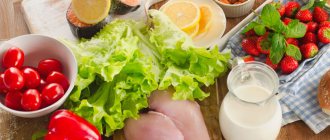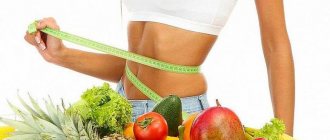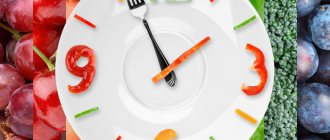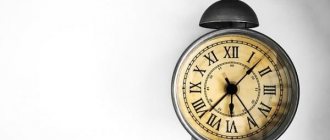Carbohydrates are the substance through which the body produces energy. Along with them, proteins and fats must be supplied so that the diet is complete. The substances are easily absorbed and quickly distributed throughout the tissues. If you follow a carbohydrate diet correctly, the amount of body fat will not increase and your weight will decrease.
Protein-carbohydrate alternation (BUCH): description of the diet, permitted and prohibited foods
Content:
- What is protein-carbohydrate alternation
- How does protein-carbohydrate cycling work?
- BUCH diet rules
- Contraindications
- Authorized Products
- Table of permitted products
- Fully or partially limited products
- Table of prohibited products
- Sample menu BUCH
- Protein day
- Carbohydrate day
- Mixed day
- Duration of the BUTCH diet and how to get out of it correctly
- Training during BUCH
Protein-carbohydrate alternation is a special diet that is in demand among athletes and even professional bodybuilders. This diet eliminates only the fat layer without affecting the muscles. As a result, a person loses weight, but maintains a beautiful relief on the body.
Proper carbohydrates for weight loss - table
Complex or regular carbohydrates are broken down more slowly, as a result of which a person experiences a feeling of satiety and a surge of energy. The main sources of energy are cereals, cereals, potatoes, some vegetables, and fruits. Simple carbohydrates are quickly digested, and after a few minutes you will want to eat again. Moreover, they provide virtually no energy, and the likelihood of fat cell deposition is high.
Foods containing large amounts of complex carbohydrates:
- lentils;
- peas;
- beans;
- beans;
- rye (unpolished);
- wheat;
- oats;
- rice (brown);
- products made from wholemeal flour - bread, muesli, pasta, whole grain flakes;
- potato;
- parsnip;
- vegetables (fresh, frozen, dried, canned);
- fruits in any form.
The second name is polysaccharides. They include starch, dietary fiber, glycogen.
Below is a table that you can easily navigate when creating a menu.
| Name | Percentage (%) |
| Cereals | |
| Buckwheat | 60 |
| Corn | 65 |
| Oats | 61 |
| Millet | 59 |
| Wheat | 60 |
| White rice | 78 |
| Brown rice | 75 |
| Rye | 54 |
| Barley | 58 |
| Vegetables | |
| Sweet potato | 17 |
| Swede | 20 |
| Potato | 18 |
| Patissons | 18 |
| Radish | 15 |
| Beet | 14 |
| Flour | |
| Corn | 65 |
| Wheat | 72 |
| Rice | 79 |
| Barley | 72 |
| Legumes | |
| Beans | 45 |
| Peas | 52 |
| Mash | 47 |
| Chickpeas | 50 |
| Soybeans | 35 |
| Beans | 38 |
| Lentils | 40 |
| Dishes | |
| Porridge | 60 |
| Kissel | 51 |
| Noodles | 65 |
| Flatbread | 52 |
| Pasta | 75 |
| Crackers | 61 |
| Rye bread | 66 |
What is protein-carbohydrate alternation
The BUTCH diet was originally created for athletes. It allowed bodybuilders to lose weight and build muscle mass. The presence of large amounts of protein and carbohydrates in the diet helped increase endurance and make training more effective. Now this diet is popular not only among athletes. It is used by ordinary women and men who want to lose weight and not lose muscle mass.
The main principle of the diet is the alternation of protein and protein foods. This diet has its own characteristics:
- complete and satisfying meals with no hunger strikes;
- safe weight loss without stress for the body;
- weight loss occurs due to fat burning, not muscle loss;
- the menu is made up of simple, inexpensive products;
- allows you to improve metabolism;
- goes well with physical activity.
Why are carbohydrates needed in a diet?
Carbohydrates are an important component involved in metabolism. For the normal functioning of the body, proteins, fats, and carbohydrates are required. Each of them plays its role. With a balanced ratio, proteins contribute to the formation of muscle mass, carbohydrates fill the body with energy, fats speed up metabolism and stimulate the breakdown of components. It is not difficult to guess what negative consequences await the human body if there is a deficiency of one of the components of the metabolic process. Carbohydrate deficiency leads to decreased physical and mental activity, chronic fatigue, loss of strength, ailments, and digestive problems.
However, everything is useful, which is normal. Excess amount of carbohydrates contributes to the deposition of fat cells, the appearance of excess weight, and the development of obesity. Calories entering the body are spent rationally during active physical activity. If you eat a lot of carbohydrates and sit on the couch, they are converted not into energy, but into fat cells. In addition, not all carbohydrates are equally beneficial. There are simple and complex connections. The former are practically not transformed into energy, the latter are rarely converted into fats. It is complex carbohydrates that are beneficial for the body, promote weight loss, improve well-being, and gain strength. The ideal ratio in the daily diet is 25%.
In addition to the energy function, carbohydrates also perform a “building” function. They stimulate the formation of cartilage and bone tissue and maintain them in normal condition. The consumption of complex carbohydrates prevents the formation of oncological tumors and ensures normal blood clotting. Important components strengthen the immune system, increase the body's protective functions, and ensure the normal functioning of the gastrointestinal tract.
How does protein-carbohydrate cycling work?
The BUTCH diet is one of the most effective. It is aimed at improving metabolism and reducing the amount of fat consumed, which leads to weight gain.
On protein days, the body does not receive carbohydrates, so energy is drawn from fat deposits. The muscles do not suffer, are not destroyed and cannot be changed. Increases endurance and physical strength. Carbohydrate days are designed to replenish lost energy. As a result of this alternation, mental abilities do not decrease and general well-being does not deteriorate.
Unlike many diets, BUCH allows the consumption of a large number of foods. You don't have to starve or give up your favorite foods. But the main condition for losing weight on this diet is endurance and motivation. It is required to follow the rules of alternation and completely avoid prohibited foods in order to lose up to 5 kg in a week.
Features of the carbohydrate diet
It is believed that obesity occurs due to the consumption of carbohydrates. This is wrong. People eat other harmful substances every day, which lead to poor health and accumulation of fatty tissue. Of all carbohydrates, only the fast variety is harmful. But without this component, normal metabolism is impossible.
The glycemic index is an indicator indicating the amount of sugar in a product. It is impossible to cancel its use. Exclusion from the diet will lead to illness. It is recommended to use products containing a low glycemic index. This indicator is calculated not only by people on a carbohydrate diet, but also by diabetics.
The features of using a carbohydrate diet are highlighted:
- drink water daily at a rate of at least 50 ml per kilogram of body;
- For one meal, eat 100 g of the product, drink 150 ml of liquid;
- food consumed per day is divided into 6 meals;
- the last meal should be no later than 18-19 pm, during this period of time metabolism slows down;
- avoiding smoking and drinking alcohol, soda, fatty and fried foods;
- daily physical activity appropriate to your health condition.
Unlike other types of nutrition, a carbohydrate diet for weight loss maintains a wide variety of foods. You can add fruits, cereals, cottage cheese. But a person is limited to portions that contain fast carbohydrates.
It is recommended to use a two-week course. In the first 7 days - the most stringent prohibitions. The amount of food and calories is strictly limited, but weight decreases quickly. In week 2, more foods are allowed, so weight loss occurs more slowly. If you add physical activity to your diet, weight loss will happen faster.
BUCH diet rules
To lose weight with protein-carbohydrate alternation, you must adhere to the following rules:
- The duration of the diet ranges from 7 to 28 days. It is not recommended to adhere to the BUCH power system for a longer period of time.
- Physical activity is required during the diet. Otherwise, protein will begin to be deposited on the stomach and waist.
- Avoid spices that increase appetite and cause fluid retention in the body. Ideally, you should stop adding salt to your dishes, but if that doesn’t work, then at least limit the amount of salt you consume.
- Don't eat foods containing sugar. This also applies to packaged juices. But freshly squeezed juices are possible.
- Food must be prepared by boiling, stewing, baking or steaming. Fried and smoked foods are completely excluded.
- Drink at least 1.5 liters of water per day. If you lead an active lifestyle, your body requires 2.5 liters of fluid per day.
The classic diagram of the BUCH system looks like this:
- 2 days of protein;
- 1 day carbohydrate;
- 1 day mixed;
- repetition of the course.
But you can cancel the mixed day, alternating 2 days of protein and the same amount of carbohydrates.
Carbohydrate diet menu
There are many options for programs for weight loss, gaining muscle mass on carbohydrates. Many diets include additional consumption of protein foods in combination with carbohydrates or alternately.
Menu for gaining muscle mass
An important condition is to correctly formulate the diet. The ratio of components for gaining muscle mass for the male and female body is presented below.
| Proteins % | Fat % | Carbohydrates % | |
| Men | 20-30 | 10-20 | 50-60 |
| Women | 40 | 20 | 40 |
It is recommended to consume daily:
- eggs;
- porridge;
- fruits;
- vegetables;
- meat;
- milk;
- oatmeal;
- brown rice;
- fish;
- cottage cheese;
- water.
Approximate daily menu for men for weight gain
| Days | Breakfast | Lunch | Dinner | Afternoon snack | Dinner | Second dinner |
| One day | Corn milk porridge, scrambled eggs, black bread toast | Nuts, pear, marmalade or marshmallows | Pearl barley porridge, beef goulash, vegetable salad, bread | Barley porridge, vegetable salad, piece of meat | Rice, sliced vegetables, chicken stewed with spices | Cottage cheese, fermented baked milk |
Approximate menu for the day for girls
| Days | Breakfast | Lunch | Dinner | Afternoon snack | Dinner | Second dinner |
| One | Milk oatmeal, ginger tea | Boiled chicken, buckwheat, vegetable salad | Rice, fish stewed in tomato sauce | Buckwheat soup with chicken broth, black bread | Cottage cheese with fruit | Milk, kefir or yogurt |
As you gain muscle mass, your body weight will increase, but this will not be due to fat deposits. Carbohydrate diets for weight gain are popular among men and women.
Drying on carbohydrates
Represents the process of drawing muscles. To highlight muscles, you need to follow a special strict diet. This is usually a high protein keto diet. As a result, excess fat cells are burned, leaving only muscle mass. Nutrition is different from a diet prescribed for weight loss.
The main rule is complete control of calories, proteins, fats, carbohydrates. During the drying process, calories are reduced by only 20%, otherwise muscle mass will begin to decrease. When consuming carbohydrates, it is very important to eliminate foods that retain fluid in the body. Fast carbohydrates can be consumed for breakfast and after training. The rest of the time you should eat complex compounds.
Approximate menu for men weighing 80 kg with 10% fat
| Norm per day | Authorized Products | Prohibited Products |
| Proteins (150 g) | Lean fish, chicken, beef, egg white | Semi-finished meat products, pork |
| Fats (100 g) | Coconut, olive oil | Sunflower oil, animal fat |
| Carbohydrates (350 g) | Buckwheat, pearl barley, vegetables | Bread, wheat, sugar, baked goods, potatoes |
Body weight needs to be monitored every day. If necessary, make adjustments to the diet.
Contraindications
Using protein-carbohydrate alternation for weight loss is prohibited if you have chronic diseases of the following organs:
- of cardio-vascular system;
- stomach and pancreas;
- kidney;
- liver.
You should not experiment with your own health during pregnancy and lactation.
The BUTCH diet is also not recommended for people with severe obesity. The reason is that with a lot of weight, a radical change in eating habits is required. And the diet is designed only for 1 month, during which you can lose a maximum of 15 kg. Obese people need a special diet.
High carbohydrate diet
Proponents of the program claim that you can lose weight by eating large amounts of carbohydrates. However, this does not mean that you have to persistently eat buns, cakes, sweets, and other sweets. We are talking exclusively about the right carbohydrates and their rational use. The essence of the diet is to spend more energy than you receive. In this case, calorie burning increases, fat disappears, and weight normalizes.
Pros of a high carbohydrate diet:
- easy to carry;
- no feeling of hunger;
- there is no risk of developing vascular diseases, as happens with a protein diet;
- weakness, chronic fatigue, decreased performance are not observed;
- there is no nervousness, irritability;
- does not suffer from insomnia;
- the functioning of the digestive tract is normalized, toxins and waste are released;
- blood pressure stabilizes.
The ideal combination is cereals and vegetables. With a high-carbohydrate diet, you do not need to take additional vitamins and minerals; they enter the body in the required quantities.
Basic Rules:
- Eat vegetables that are high in starch. At first glance, this requirement seems absurd, since starch is converted into fats. The idea is that after eating starchy vegetables, you feel full for a long time and don’t want to eat. This way you can avoid unnecessary snacking.
- Watch your portions. The amount of starchy carbohydrates in the total diet should be 1/3. The rest of the products are fruits, cereals, vegetables. You need to eat less, but more often. You are allowed to eat raisins and nuts as snacks. They will stop the feeling of hunger, lift your mood, and improve brain function.
- Contrary to all stereotypes, you need to eat sweets. Therefore, you should not completely give up sweets, chocolate, jam, and ice cream. You just need to minimize the portion. If you want sweets, eat one, chocolate - ¼ bar, ice cream - no more than one pack. The rest of the diet needs to be adjusted so that there is no excess carbohydrates and fats.
A high-carbohydrate diet is not a food restriction, a separate weight loss program, but rather a proper nutrition system. The body adapts to the new rules, metabolism accelerates, weight returns to normal, and the results last a long time.
Authorized Products
Protein-carbohydrate alternation involves three stages:
- Protein. These days you need to consume 3-4 grams of protein per kilogram of weight (desired). Fats and fiber are strictly limited - no more than 10% of the total food volume.
- Carbohydrate. During this period, prepare meals from carbohydrate products at the rate of 6 grams of carbohydrates per kilogram of desired weight. Protein is allowed, but not more than 1 gram per kilogram of weight.
- Mixed. Consume 3 grams of protein and carbohydrates for every kilogram of weight.
On the BUCH system it is allowed to consume meat products, cereals, vegetables and fruits.
Table of permitted products
What foods can you eat with protein-carbohydrate alternation:
| Protein days | Carbohydrate days |
| lean poultry (breast) | cereal porridge |
| lean beef and veal | starchy vegetables |
| seafood and fish | whole grain breads and crispbreads |
| eggs | durum wheat pasta |
| dairy | any fruit |
| nuts | |
| non-starchy vegetables |
On mixed days, breakfast and lunch should consist of carbohydrates; in the afternoon, gradually switch to proteins. This will help prepare you for the upcoming protein load.
Peculiarities
There are a large number of carbohydrate diets that are used for weight loss, or for gaining muscle mass or weight. There are general rules for all of them:
- You need to eat 4-6 times a day.
- Have dinner no later than 19:00.
- Drink only water or tea.
- Eat no more than 100-150 g of carbohydrates at one time.
- The amount of sugar in food should be minimal.
- You should not snack between meals.
Although complex carbohydrates are predominantly present in the diet, there is also a place for simple saccharides. Naturally, nutrition is not complete without proteins and fats. The menu is varied and balanced.
pros
- There is no constant feeling of weakness, dizziness, or drowsiness.
- By avoiding fats and taking large amounts of vegetables and fruits high in carbohydrates, the functioning of the cardiovascular system is optimized.
- Blood sugar levels decrease.
- Metabolic processes are accelerated.
- The diet is well tolerated and does not lead to gastrointestinal upset.
Minuses
Due to the limited amount of food consumed, a person does not immediately feel full. And that's why breakdowns often occur. Instead of 100-150 grams of food, he eats much more, which makes his attempts to lose weight pointless.
List of approved products
- Legumes: beans, peas - in any form, including canned;
- grain crops;
- porridge cooked in water without salt, preferably buckwheat and oatmeal;
- low-starch vegetables: asparagus, any cabbage, carrots, celery, etc.;
- fruits;
- juices from fruits and vegetables;
- milk and dairy products;
- lean meat;
- whole wheat bread.
Prohibited Products
- Confectionery and sugar;
- bakery;
- smoked meats and fatty foods;
- alcohol;
- carbonated drinks.
Fully or partially limited products
To lose weight using the BEACH system, you will have to give up fast food, sweets and flour products. Despite the need to consume carbohydrate foods, preference is given to slow carbohydrates, for the digestion of which the body spends a lot of energy. But sugar and all sweets are fast carbohydrates, which cause weight gain and an increase in blood glucose levels. For this reason, they are strictly prohibited.
All fatty foods are also prohibited. If you cook chicken, be sure to remove the skin. When purchasing meat, choose lean varieties.
Dairy products are allowed on the diet, but only low-fat or low-fat (no more than 4%). This rule applies to cheeses, milk, kefir, and yogurt.
Table of prohibited products
Which products can be consumed in limited quantities and which ones will have to be completely abandoned:
| Rarely possible | It is forbidden |
| butter | mayonnaise |
| wine | ketchup |
| fast foods | sugar-containing products |
| vegetable oils | sweet sodas |
| rich broths | alcohol other than wine |
Carbohydrates during pregnancy
Complex compounds contain protein, fiber, and minerals necessary for the normal functioning of the mother and fetus. The exact daily intake during pregnancy has not been established. Experts believe that 60% of daily calories consumed will be sufficient. Carbohydrates prevent exhaustion of the body, weakness, nausea, improve the functioning of the digestive tract, and save from anemia and changes in blood pressure. These same components will help control weight.
Approximate menu for the day
| Breakfast | Lunch | Dinner | Afternoon snack | Dinner | Second dinner | |
| Dishes | Oatmeal with dried fruits, yogurt | Oatmeal cookies, green tea | Rice, boiled chicken, vegetable salad | Fish with vegetables, mashed potatoes | The vinaigrette | Curd casserole, kefir |
During the day you should drink at least 1.5 liters of still mineral water.
Sample menu BUCH
Based on the list of permitted products, you can create a menu for weight loss. You should have 3 full meals and 2-3 snacks. Be sure to take into account the calorie content - for women it should not exceed 1200 kcal per day, for men - 1400 kcal. With an active lifestyle, an increase in this indicator is allowed.
As a snack you can eat:
- nuts;
- vegetables and fruits (unsweetened);
- kefir and natural yogurt;
- hard cheeses.
You can prepare yourself light vegetable or fruit salads with natural dressing. And be sure to follow the drinking regime. The first intake of liquid should be in the morning, 30 minutes before breakfast. During the day - 1 hour after meals and half an hour before meals.
Protein day
On protein days, you can cook your favorite dishes from meat, eggs or cottage cheese. The choice of food seems limited, but in reality you won't go hungry.
A sample menu on the first protein day looks like this:
- Breakfast - boiled egg, vegetable salad with flaxseed oil, green tea.
- Second breakfast – cottage cheese with cinnamon.
- Lunch – steamed fish with zucchini.
- Afternoon snack – nuts.
- Dinner – boiled chicken breast with lettuce.
- Late dinner - kefir.
Second protein day:
- Breakfast – natural yogurt.
- Second breakfast – 2 egg omelet, tea.
- Lunch – chicken breast broth with bread or crackers.
- Afternoon snack – fermented baked milk.
- Dinner – stewed fish with vegetables.
- Late dinner - salad of vegetables and boiled beef, seasoned with natural yogurt.
Carbohydrate day
On carbohydrate days, the diet is more varied. The main thing is to completely eliminate fats. A small amount of protein is allowed - this can be a glass of kefir, a piece of chicken breast or 1 egg.
An approximate menu for the first carbohydrate day looks like this:
- Breakfast - oatmeal on water with fruit, tea.
- Second breakfast – banana.
- Lunch – boiled macaroni and cheese.
- Afternoon snack – apple.
- Dinner – rice with vegetables.
- Late dinner – vegetable juice.
Second carbohydrate day:
- Breakfast – buckwheat porridge.
- Second breakfast – fruit smoothie.
- Lunch – brown rice with chicken.
- Afternoon snack – banana.
- Dinner – vegetable salad with vegetable oil.
- Late dinner - any fruit.
Mixed day
On mixed days you need to eat protein and carbohydrate foods. Again, cut out fats and sugar. A sample menu looks like this:
- Breakfast – oatmeal on water with honey, green tea.
- Second breakfast – a glass of kefir.
- Lunch – veal with rice.
- Afternoon snack – salad of vegetables and cheese.
- Dinner – steamed fish with buckwheat porridge.
- Late dinner - a glass of milk.
Drying
Traditionally, cutting involves an almost complete rejection of carbohydrates. However, there are systems by which you can get rid of excess fat by eating low-carbohydrate foods. In this case, it is important to strictly follow the list of permitted products and not go beyond it. Since blood sugar levels drop sharply, attacks of dizziness and weakness are possible in the first week of this marathon.
So, when drying on carbohydrates, the following are allowed:
- cereals - buckwheat and rice;
- legumes;
- vegetables;
- lean meat;
- fruits;
- milk;
- cottage cheese.
All food containing fast carbohydrates is prohibited. Traditionally these are sweets, flour, potatoes, carbonated drinks, sugar and fast food. All this is replaced by products with slow saccharides. Thanks to this diet, you will feel cheerful, get rid of attacks of insatiable appetite and be able to lose fat ballast without unnecessary stress.
Features of drying on carbohydrates
- All sugars must be consumed in the first half of the day.
- The duration of this diet should not exceed 5 weeks.
- You need to eat 2 hours before training and 2 hours after it.
- The amount of carbohydrates consumed weekly is reduced by 10-20%. At the end of the diet, the percentage of such food in the diet is close to zero.
- Exactly how many carbohydrates you need to eat per day is calculated by the formula: per 1 kg of weight there are 2 g of carbohydrates per day.
- During drying, it is necessary to keep a diary of calorie intake, where you need to write down all the food you eat and record the percentage of BJU in it.
- It is better to exclude salt, oil and seasonings from the diet - they stimulate the appetite and force a person to eat more than necessary.
- A prerequisite for drying is intense training, which should become richer the more protein there is in the diet.
- You need to drink plenty of fluids. Each meal ends with a cup of unsweetened tea or a glass of water.
- To increase the protein in your diet before training, you can drink a protein shake, which will increase the rate of muscle growth.
Weekly nutrition table
| weeks | Breakfast | Lunch | Dinner | Afternoon snack | Dinner | Snack |
| 1 | egg, oatmeal | handful of dried fruits | buckwheat porridge, 2 egg whites | 2 bananas, 40 g nuts | portion of boiled shrimp, vegetable salad | 100 g cottage cheese with berries |
| 2 | 4 egg omelette | tofu cheese, 2 whole grain toasts | 150 g turkey, vegetables from the oven | 100 g chicken breast, 2 whole grain toast | piece of red fish, fresh vegetables | 3 egg whites |
| 3 | 1-2 pancakes with fish | 3 egg whites, 2 bananas | 50 g durum pasta, a piece of beef. vegetables | protein shake, 1 apple and 1 banana | stewed squid, pumpkin | 100 g cottage cheese with berries |
| 4 | 100 g oat flakes with candied fruits, 0.5 l milk | 3 chicken whites, canned peas or corn | 150 g turkey, vegetable salad | 300 g yogurt (unsweetened) | 150 g chicken breast, stewed vegetables | 100 g cottage cheese |
| 5 | 4 egg whites + 1 yolk, 2 pieces of toast, half an avocado | 100 g cottage cheese, orange, banana | 150 g oven-baked potatoes, a piece of red fish, Brussels sprouts | protein shake, dried fruits. | 150 squid, vegetable salad | 400 ml kefir with bran. |
The most difficult week is the third. The amount of carbohydrates at this stage is extremely low, and training should be the most intense. The 5th week is the most comfortable, since it is considered a “day off”. Then you can return to your previous diet without any problems. Although the diet is quite balanced, it is necessary to take vitamin complexes.
Duration of the BUTCH diet and how to get out of it correctly
The duration of the diet ranges from 7 to 28 days. During this time you can lose weight:
- in 7 days – up to 5 kg;
- in 10 days – up to 7 kg;
- in 14 days – up to 10 kg;
- in 28 days – up to 15 kg.
The result directly depends on the weight. The higher it is, the more active the reduction in body weight. At the same time, the BCH system allows you to achieve your physiological weight, and not lose more weight than normal, as during hunger strikes.
To maintain the results, you need to exit the diet correctly. For the last week, change the system daily (protein, carbohydrate, mixed period and again). Then begin to gradually introduce foods from your usual table. Add 1-2 new dishes to your diet every day, including fats. And only a month after completing the diet you can return to your usual diet.
Low carb diet
A special nutrition system with a predominance of protein foods. There are practically no carbohydrates in the daily diet; fats are used in small quantities. You cannot stick to a low-carb diet for a long time. Maximum – 1 month. After achieving the desired results, they switch to proper nutrition. The essence of the diet program is to reduce the calorie content of food, due to which already accumulated fat is burned.
List of permitted products:
- meat - pork, lamb, veal, chicken, turkey;
- eggs;
- offal;
- mushrooms;
- dairy products;
- nuts, seeds;
- vegetables - except beans, corn, beans, peas, potatoes, avocados, lentils, black olives;
- brown rice, bran, buckwheat;
- any fruit except bananas and grapes.
All other products are strictly prohibited.
Menu for the week
| Days | Breakfast | Dinner | Afternoon snack | Dinner |
| 1 | Cottage cheese, apple, coffee or tea without sugar | Buckwheat with meat | Orange | Fish with vegetables |
| 2 | Omelet, apple, coffee or tea | Mushroom soup | Yogurt, fruit | Beef stew with vegetables, salad |
| 3 | Cheese, orange, coffee | Buckwheat soup with chicken broth | Apple, yogurt | Cabbage stewed with meat |
| 4 | Milk buckwheat porridge, tea | Rice with fish, vegetable salad | Pear | Chicken breast with vegetable salad |
| 5 | Boiled eggs, cheese, tea | Borsch with meat, sour cream | Lean pork, vegetables | Stew of vegetables, meat, kefir |
| 6 | Cottage cheese with dried fruits, green tea | Soup with rice and meat broth | Apple | Fish in tomato sauce |
| 7 | Buckwheat | Mushroom soup | Yogurt, orange | Chicken cutlets, vegetable slices |
If necessary, the diet is extended for another week. The diet can be repeated from the first day or you can create your own using approved products.
Training during BUCH
An important condition for losing weight using the BEACH system is regular training. Continue to exercise if you lead an active lifestyle. If you haven’t been interested in training before, then it’s time to start.
Choose the sport at your discretion. This could be daily aerobics, running, yoga. The more intense the load, the more beautiful the body will be after completing the diet. The main thing is not to overdo it, especially if your body is not prepared for sports. Take a break by exercising no more than 3 times a week.
The BUTCH system is a great way to lose weight. It is suitable for athletes and people leading a sedentary lifestyle. But you will have to give up fats and sweet foods in order to lose 8 or more kilograms in a month.
Malysheva's diet
The weight loss program is designed for 2-3 months. The diet is extensive, the list of allowed foods is large. In general, Malysheva’s diet differs little from the usual proper nutrition, which is recommended by many experts. She advises excluding vegetable oil, butter, fatty meat, rice, pasta, carrots, beets, alcoholic beverages, and flour from the diet.
Menu for 5 days
| Day | Breakfast | Lunch | Dinner | Afternoon snack | Dinner | Second dinner |
| 1 | Oatmeal with milk | Cottage cheese casserole | Boiled beef, broccoli | Apples | Stewed cabbage | Kefir |
| 2 | Omelet with cheese | Yogurt | Vegetable soup, rye bread | Orange | Cottage cheese | Kefir |
| 3 | Oatmeal with water and dried fruits | Cabbage salad with cucumber | Buckwheat, stewed fish | Cottage cheese | Stewed cauliflower | Kefir |
| 4 | Cheese, boiled egg, rye bread | Yogurt | Chicken, buckwheat | Fruits | Syrniki | Kefir |
| 5 | Milk buckwheat porridge | Tomato salad with cheese, olive oil | Ear | Fruits | Vegetable stew | Kefir |
Malysheva promises to lose 500 g of weight every day. You need to eat in small portions and drink 1.5 liters of water per day. There are actually many options for dinner. The basic rule is that food should be light and easily digestible. Immediately before bed, it is better to drink a glass of kefir. The fermented milk product will help bring the intestinal microflora in order.
No Carbohydrate Diet Chart
In order to correctly create a menu, you need to know how many carbohydrates the product you need contains. The basic rule of the diet is a limited amount of carbohydrates per day. A table with a clear indication of carbohydrate content will help in selecting food products.
| Product/Dish per 100 g | Amount of carbohydrates (in grams) | |
| Seafood, fish | Smoked salmon | 0 |
| Smoked herring | 4 | |
| Salted herring | 2 | |
| Shrimps | 0 | |
| Squid | 4 | |
| Boiled fish | 3 | |
| Dairy products | Cottage cheese | 3 |
| Sour cream | 5 | |
| Kefir, unsweetened yogurt | 5 | |
| Various types of cheeses | 0.5-2 | |
| Milk | 2,4 | |
| Eggs | Regardless of cooking method | 0.5 |
| Fats | Butter | 5 |
| Vegetable oil | 0 | |
| Margarine | 5 | |
| Mayonnaise | 5 | |
| Vegetables | Carrot | 5 |
| Canned tomato | 4 | |
| Pickle | 2 | |
| Fresh tomato | 6 | |
| Fresh cucumber | 3 | |
| Eggplant | 2 | |
| Onions (1 pc.) | 8 | |
| Green onions (1 tbsp.) | 5 | |
| Zucchini | 4 | |
| Radish | 0,5 | |
| Beetroot (1 pc.) | 6 | |
| Mushrooms | 5 | |
| Green beans | 8 | |
| Boiled cauliflower | 6 | |
| Fresh white cabbage | 5 | |
| Sauerkraut | 3 | |
| Nuts | Peanuts (2 tbsp.) | 1.8 |
| Hazelnuts (2 tbsp.) | 1.2 | |
| Almonds (100 g) | 11 | |
| Cedar (2 tbsp.) | 1.7 | |
| Fruits (1 piece) | Apricot | 3 |
| Plum | 8 | |
| Lemon, tangerine | 6 | |
| Apple | 18 | |
| Orange | 17 | |
| Pear | 25 | |
| Kiwi, peach | 9 | |
| Berries | Cranberries (1 cup) | 8 |
| Cherry | 16 | |
| Blueberry | 21 | |
| Raspberries | 17 | |
| Black currant | 19 | |
| Juices | Apple, tomato, grape | 4 |
| Meat | Steak | 1 |
| Meat fried in breadcrumbs | 5 | |
| Meat with flour sauce | 6 | |
| Boiled meat | 0 | |
| Sausages, ham, sausage | 1 | |
| Boiled chicken | 0 | |
| Pork goulash | 9 | |
| Veal goulash | 2 | |
| Beef stew | 5 | |
| Beef liver | 6 | |
| Chop | 0 | |
Please note that each day's menu must be divided into five meals. With fractional meals, there is no feeling of hunger. The diet includes a large amount of protein, so a person’s muscle tissue is not destroyed, and fat tissue is burned even in a relaxed state. The low carbohydrate content in the menu causes the body to release special substances (ketones) into the blood that can have a toxic effect, so a low-carbohydrate diet is contraindicated for people with liver and kidney dysfunction.
Diet options
The carbohydrate diet is divided into several types. When choosing the optimal nutrition option for yourself, consider:
- general condition of the body;
- volume of excess fat deposits;
- age;
- level of physical activity;
- contraindications.
It is difficult to choose the right dietary diet on your own; it is better to consult a nutritionist with this question.
Easy option
You can eat this way for a long time. A light carbohydrate diet normalizes lipid and carbohydrate metabolism, the body does not experience a deficiency of vitamins and minerals. As a result, weight is lost without harm to health. On average, about 2 kg are burned per week. Losing weight is not fast, but you can be sure that the extra pounds will not return.
The only thing you have to give up on a light diet is sugar and baked goods made from wheat flour.
The advantage of a carbohydrate diet for weight loss is the variety of menus for every day. A sample menu is shown in the table below.
| breakfast | dinner | dinner | |
| Monday | omelette with asparagus | vegetable stew, salad with sunflower oil | baked chicken breast, fresh vegetable salad |
| Tuesday | two boiled eggs, orange | baked fish with green beans | cauliflower stew, fresh vegetable salad |
| Wednesday | muesli, kefir | Lentil soup, olive oil salad | boiled beef, stew with mushrooms |
| Thursday | whole grain bread with lean cheese and herbs | baked chicken breast, rice porridge | seafood salad |
| Friday | low-fat cottage cheese with nuts | pasta with seafood and tomatoes | baked eggplant in garlic sauce |
| Saturday | omelette with tomatoes, mushrooms and herbs | baked fish with asparagus | chicken salad |
| Sunday | muesli, fermented baked milk | pea soup, vegetable salad | boiled lamb, vegetable stew |
The diet does not cause psychological difficulties, because you do not have to give up your usual foods. However, in order not to feel hungry between main meals, you should have light snacks. You can eat some fruit, some nuts, yogurt.
Strict version
A strict carbohydrate diet for weight loss is optimal if you urgently need to lose excess weight. For example, when preparing for a holiday event. You will lose weight quickly, but sticking to a strict diet is difficult, and you can’t do it for long. There is also a high probability that after completing the diet, the extra pounds will return in the same amount.
The diet lasts a week and allows you to lose 6-8 kg. In order to avoid gaining excess weight again, after a week of fasting, it is necessary to remove fatty foods, sweet pastries and confectionery from your diet. Before starting the diet, it is advisable to spend one fasting day, consume only low-fat kefir and water. It is permissible to eat a strict carbohydrate diet no more than once a month.
An approximate menu of a strict carbohydrate diet for weight loss for each of the seven days is below in the table.
| Monday | baked potatoes without salt with fresh herbs, low-fat kefir |
| Tuesday | low-fat cottage cheese |
| Wednesday | fruits, low-fat kefir |
| Thursday | boiled chicken, low-fat kefir |
| Friday | fruits, low-fat kefir |
| Saturday | mineral still water |
| Sunday | fruits, low-fat kefir |











